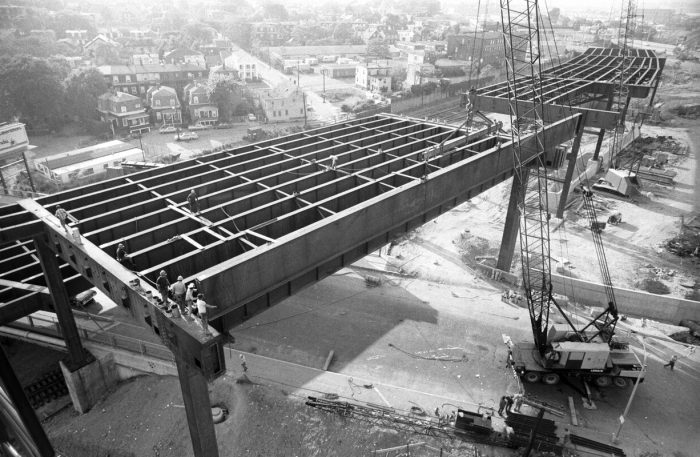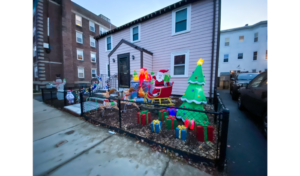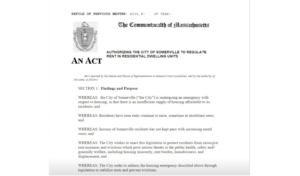Photo by Spencer Grant, Boston Public Library, Digital Commonwealth
The legacy of the roadway goes deep, with a strong push from activists in the 1970s
The Somerville Wire recently received a Kozik Environmental Justice Reporting Grant, through the National Press Foundation and the National Press Club Journalism Institute. This article is the third in a series about how roadways like I-93 and others in East Somerville have posed health risks to residents, many of whom are immigrants and working-class individuals. Not only do highways present barriers, dividing East Somerville from other neighborhoods, but residents face the prevalent threat of air and noise pollution. Advocates have said that this is not an accident. Here is a look at the history of how I-93 was first built.
(Somerville Wire) – I-93 is notorious for dividing East Somerville from other neighborhoods and for the noise and air pollution that threaten the health of people who live in its vicinity. Construction on the section of the interstate that runs south from Medford through Somerville and Boston was completed in 1973, but prior to this milestone, residents actively protested and fought its expansion. The community was composed primarily of working class people, many of whom were Italian, Irish, or Portuguese immigrants, and while the protesters put up a tough fight, they were not, in the end, able to effect change. The activists’ work is a prime example of how because of a lack of political power, a local population failed to have its voices heard, an existing neighborhood was demolished, and people’s health and safety were compromised.
Mary Cassesso, a former candidate in this year’s mayoral election, remembers what it was like to have her family involved in East Somerville’s movement. Her family was particularly active in the protesting, and she was a youth growing up in the midst of the construction. Her mother, Barbara Cassesso, and her aunt, Dolores Lapiana, were particularly active in a group called the East Somerville Committee Action group, which had an offshoot known as Somerville Citizens for Adequate Transportation. Mary described how in some actions, people would arrive at the scene of construction and stand in front of bulldozers. ESCA made a number of demands, including a proposal for I-93 to go underground, so that it would not isolate a section of the city and would pose fewer health risks. Mary said that she remembers the group also asking for double paned windows, central air in buildings, and trees for beautification. But in spite of the dedicated protest movement, the highway was constructed aboveground.
“They [ESCA] kept saying a wall would be a psychological barrier,” Mary said of the interstate that was built. “Nothing ever got done. The only thing they felt was a real accomplishment is that Governor [Frank] Sargent put a moratorium on all additional highway building … The group put up quite a battle. My mother reminded me that they were in the Bunker Hill parade one year, carrying a casket, with a banner that said ‘Bury I-93.’ I don’t know if anybody feels that any good came of it, but they didn’t just accept what was [an agreement without community process] to destroy neighborhoods.” She added, “They felt as if they never had a chance to stop I-93 completely.”
According to an article published in BioMed Central in 2020, an informant claimed that Somerville during this time had “incredibly corrupt politics.” Barbara described how the Mayor of Somerville from 1962-1967, Larry Bretta, pushed for the roadway and how Somerville lost its rights to veto the construction. An “Impact Study of Interstate Highway 93 on Somerville” published by the law firm Justin Grey Associates in March 1970 explains how in May 1969, Sargent instructed his task force on transportation to advise him whether current highway plans took adequate account of “the housing crisis of the metropolitan area,” “the effect on community life,” and “the effect upon environment.” The study came to the following conclusion: “The elevated design of I-93 repeats the worst mistakes of the past: the very same mistakes which the governor’s task force was mandated to expose.” Meanwhile, a series of lawsuits were filed in an attempt to halt the construction. One of these was initiated by SCAT in May of 1970, and it held that the planned road “violates provisions of both the Federal Highway Acts of 1966 and 1968 and the National Environmental Policy Act of 1969.” Air pollution expert Wig Zamore said that Greg Ingram, formerly of the Lincoln Institute of Land Policy in Cambridge, warned about the effects of placing a strongly concentrated population alongside heavy transportation.
“… Putting that highway through the center of the densest and most [vulnerable in terms of environmental justice] part of Somerville, which is the densest city, out of 351 cities, in the state, was exactly what Greg Ingram had warned about, but on steroids,” said Zamore. “The health effects were massive. At that time, we still had lead in gasoline. The environmental studies that were done for that showed not only large increases in the big particles, which were the only particles that were regulated initially by the Clean Air Act, but also very large increases in lead. And people knew, by then, that the lead was causing permanent brain damage in children.”
In a May 1970 article in the Somerville Journal, hazards posed by the construction of the interstate were outlined. These included “open, unfenced trenches filled with water, heavy machinery left unguarded after working hours, potholes, compressed gas tanks left where children can play, and driving obstructions without proper detour signs.” Perhaps one of the greatest tragedies was described in a March 1970 Somerville Journal article, called “Two Playmates Buried Wed[nesday].” Two young boys, Charles Harris, age 5, and Craig Fletcher, age 4, died when they fell into an excavation ditch in East Somerville. They had been playing together, as they regularly did, and had been some 100 feet from home.
“The youngsters had apparently been playing on a pole which jutted out of the ditch at the I-93 extension construction site near Middlesex and Mystic Avenues,” reads the article. It later states, “Both were taken still breathing to Somerville Hospital and one hour later to Children’s Hospital Medical Center. The Fletcher child died at 3:50 p.m. His playmate died at 9:52 p.m.”
Linda Sprague Martinez, a professor at Boston University’s School of Social Work, emphasized that while the activists were not able to bring about change, their work was still important. Their efforts help us to understand what Somerville’s politics were like at the time and how they have evolved into what they are today.
“It’s important for us to understand political activism from a historical perspective, because it helps us in our present-day planning,” said Sprague Martinez. “It also tells us a bit about the style. One of the things that we see in Somerville today is populations once minoritized now have political power. You have the folks who are able to really move things. … There are populations in power now that didn’t always have political power. … Today, the Somerville approach is top down in many ways, from an organizing standpoint. … when you look at the way people organize … they have direct access to political leaders. They have direct access to state and local leaders. It’s very different from a community where you don’t have that access, you’re shut out, and you have to go door to door. … It’s positive in the sense that they’re in a very good place today, in terms of their activism, but I think, perhaps because of their history, they also work to be inclusive, which may take into account the fact that they didn’t always have that access.”
Barbara explained how the protesters, though persistent, were just a small community group. The demolitions impacted the neighborhood, and some residents moved away when they saw the effects of the construction. Barbara still remembers what it was like to be part of the resistance, and she reflected on what the battle meant to her.
“We were a small group, without any power, fighting to change things for the better of Somerville. We did the best we could,” said Barbara.“… The city was divisive, at that time. What happened in Ward 1 didn’t affect Ward 7. People were not involved. We were the first community group in the city to form a group.” She added, “It really affected a lot of people. Some people moved out because they didn’t know what the neighborhood would be like after that. It just changed everything. … It devastated our neighborhood. It took us a long time to recuperate.”
This article is syndicated by the Somerville Wire municipal news service of the Somerville News Garden project of the Boston Institute for Nonprofit Journalism.
All Somerville Wire articles may be republished by community news outlets free of charge with permission and by larger commercial news outlets for a fee. Republication requests and all other inquiries should be directed to somervillewire@binjonline.org.
SUBSCRIBE TO THE FREE SOMERVILLE WIRE EMAIL NEWSLETTER: https://eepurl.com/hpBYPv
Check out all our social media here: https://linktr.ee/SomervilleWire.
Shira Laucharoen is assistant director of the Boston Institute for Nonprofit Journalism and assistant editor and staff reporter of the Somerville Wire.





